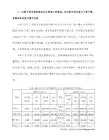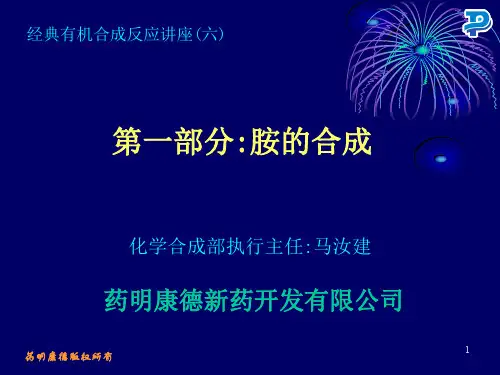药明康德酰胺的合成ppt课件
- 格式:ppt
- 大小:3.40 MB
- 文档页数:62



经典化学合成反应标准操作氰基转化为酯和酰胺目录1.前言 (2)2.氰基转化为酯 (2)3.氰基转化为酰胺 (2)3.1丙稀酰胺的合成 (2)3.2苯乙酰胺的合成 (3)6. 从氰基合成酰胺6.1氰基水解腈加水可以分解为伯酰胺。
由于伯酰胺会继续水解为羧酸,一般要控制水解的条件。
目前有许多方法报道,有时需要根据底物的特性选择酸性,碱性或中性的水解条件。
作为中性的条件,也有文献报道使用镍或钯催化剂的方法。
在酸性条件下与饱和碳相连的氰基,可以在酸中很方便的水解转化为酰胺,并在条件较为剧烈时,很容易进一步水解成酸。
但乙烯基或芳基腈的水解条件则要求剧烈得多,一般需要强酸条件,而且一般不会进一步水解。
在碱性条件下,利用过氧化氢氧化的方法可在室温下短时间内水解腈为伯酰胺,这是一个较为可靠的方法。
利用NaOH(aq.)-CH2Cl2相转移催化体系,DMSO-K2CO3体系[2]可以用于各种腈水解为伯酰胺。
6.1.1 盐酸水解腈为伯酰胺示例[3]HCl, H2OCN CONH2In a 3-l. three-necked round-bottomed flask equipped with glass joints are placed 200 g. (1.71 moles) of benzyl cyanide and 800 ml. of 35% hydrochloric acid. The flask is fitted with a reflux condenser, a thermometer, and an efficient mechanical stirrer. At a bath temperature of about 40° the mixture is stirred vigorously. Within a period of 20–40 minutes the benzyl cyanide goes into solution. During this time, the temperature of the reaction mixture rises about 10°above that of the bath. The homogeneous solution is kept in the bath with, or without, stirring for an additional 20–30 minutes. The warm water in the bath is replaced by tap water at about 15–20°, and the thermometer is replaced by a dropping funnel from which 800 ml. of cold distilled water is added with stirring. After the addition of about 100–150 ml., crystals begin to separate. When the total amount of water has been added, the mixture is cooled externally with ice water for about 30 minutes. The cooled mixture is filtered by suction. Crude phenylacetamide remains on the filter and is washed with two 100-ml. portions of water. The crystals are then dried at 50–80°. The yield of crude phenylacetamide is 190–200 g. (82–86%).6.1.2 浓硫酸水解不饱和腈为伯酰胺示例[4]CN CONH 21. H 2SO 42. NH 3To 106 g of 84 % sulfuric acid, was added 50 g of acrylonitrile. After stirring for 30 min at r.t., the resulting mixture was heated to 95 ℃, and stirred for 2 h. After cooling, the solid was collected by suction, and the filter cake was transferred into a beaker. To the ice-cooled solid, was added aq. ammonia with the speed that keep the temperature less than 50℃. The precipitated ammonium sulphate was filtered off, and the filtrate was cooled. The precipitate was collected by filtration, and the filter cake was washed by water, dried in vacuum to give the desired product.6.1.3 H 2O 2-K 2CO 3-DMSO 体系水解腈为伯酰胺示例[1] Cl CN30% H 2O 2, K 2CO 3DMSO, rt, 5 min ClONH 2To a stirred solution of 4-chlorobenzonitrile (1.37 g, 0.01 mol) in DMSO (3 ml), cooled in a ice bath, was added 30% H 2O 2 (1.2 ml) and K 2CO 3, the reaction was allowed to warm up to r.t. (strong exothermic effect was observed). After 5 min., distilled water (50 ml) was added, cooling applied, and the product was collected by filtration, yield 85%.6.1.4 NaOH(aq.)-CH 2Cl 2相转移催化体系水解腈为伯酰胺[2] CN (n -C 4H 9)N +HSO 4-30 % H O , CH Cl NH 2OTo a magnetically stirred dichloromethane solution (1.5 ml) of o -tolunitrile (0.5 g, 4.27 mmol) cooled in an ice ba th, are added 30% hydrogen peroxide (2.0 ml), tetrabutylammonium hydrogen sulfate (0.290 g, 0.85 mmol), and a 20% aqueous solution of sodium hydroxide (1.6 ml). Thereaction mixture is allowed to warm up to r.t. and maintained under stirring. After 1.6 h, dichloromethane is added, the organic layer is separated, washed with brine, and dried with sodium sulphate. The solvent is removed under reduced pressure to leave a white solid from which pu re o-toluamide is obtained by chromatography on silica gel. Yield 0.485 g (97%).6.2 Ritter反应碳正离子加成到腈基的氮原子上生成的腈盐加水分解得到相应的酰胺加水可以分解为酰胺。

经典化学合成反应标准操作酯交换为酰胺编者:杜晓行药明康德新药开发有限公司化学合成部目录1.前言⋯⋯⋯⋯⋯⋯⋯⋯⋯⋯⋯⋯⋯⋯⋯⋯⋯⋯⋯⋯⋯⋯⋯⋯⋯22.酯交换为酰胺⋯⋯⋯⋯⋯⋯⋯⋯⋯⋯⋯⋯⋯⋯⋯⋯⋯⋯⋯⋯⋯⋯23.酯交换为N-取代酰胺⋯⋯⋯⋯⋯⋯⋯⋯⋯⋯⋯⋯⋯⋯⋯⋯⋯⋯⋯21.前言酯和氨水反应可以很方便地得到酰胺。
N-取代酰胺一般可以利用相应的胺与酯直接反应得到,在有些条件下,需要有铝试剂的存在反应才能够顺利进行。
2.酯与氨交换一般酯的氨解通过氨的醇溶液或氨水来进行。
氨的醇溶剂氨解反应可通过加入适量的甲醇钠和氰化钠来催化。
用氨水直接氨解一般需要加热(当该反应温度到100 度时,一定要用高压釜做这一反应),这类反应一般可以通过硫酸铜来进行催化。
反应的条件选择主要看酯的活性程度,一般脂肪酸酯的交换要比芳香羧酸酯来得容易,甲酯要比乙酯来得快。
对脂肪酸酯,α位的位阻大小也决定了反应的快慢。
酯通过甲酰胺在乙醇钠的存在下,高温也可得到相应的酰胺。
这一方法对各类的酯都比较有效,只是产品的分离比直接氨解稍微麻烦一些,但反应较快。
另外近年来,AlMe 3-NH 4Cl 或Me2AlNH 2在多官能团及复杂化合物的合成中用的较多,该方法条件较强,各类酯都能很快的氨解。
其缺点是AlMe 3易自燃,操作不是太方便。
2.1 氨水用于脂肪羧酸酯氨解示例[1]To ethyl 5-ethoxycarbonylmethyl-3-methylisoxazole-4-carboxylate (1.00 g, 4.15 mmol) was added an excess ocf onc. aqueous ammonia d( = 0.88 kg dm·-3, 5.0 cm3) and EtOH (3.0 cm3), and the suspension was stirred vigorously at room temperature for 14 h. After this period a white solid had precipitated which was filtered and recrystallized (EtOAc) to yield the desired product as a white solid (0.81 g, 92%).HO O N OPrepared as described above for ethyl 5-carbamoylmethyl-3-methylisoxazole-4-carboxylate but using methyl-5-ethoxycarbonyl- 3-methylisoxazole-4-carboxylate(1.00 g, 4.15 mmol) and methylamine in toluene (30% w/v, 10.0 cm 3), to yield the desired product as a white solid (0.93 g, 99%).2.2 氨甲醇氨解脂肪羧酸酯示例 [2] [3]The ester (4.11 g, 14 mmol) was dissolved in absol. methanolic ammonia (100 ml, 20 % NH 3), and the solution was allowed to stand at temperature for 3 days, the solvent was then evaporated, and the resulting crystalline was purified by recrystallization.2.3 氨水用于芳香羧酸酯氨解示例 [4]To an autoclave, was added methyl 6-methylniconate (500 g, 3.31 mol)s, at. aq. NH 4OH (500 ml) and ethanol (500 ml). After sealing, the reaction was heated to 80℃ for 2 days. The cooled reaction mixture was filtrated, and the filter cake was recrystallized to afford white solid (247 g, 54.8%)。


十种酰胺合成方法:机理、特点、应用-----药明康德马汝建(一)碳二亚胺类缩合剂法常用的缩合剂主要有3种:二环己基碳二亚胺(DCC)、二异丙基碳二亚胺(DIC)和1-(3-二甲胺基丙基)-3-乙基碳二亚胺(EDCI)。
使用该类的缩合剂一般需要加入酰化催化剂或活化剂,如DMAP、HOBt等。
由于在反应的第一阶段酸对碳二亚胺的加成中间体其并不稳定,若不用酰化催化剂转化为相应的活性酯或活性酰胺,其自身会通过重排成相应的稳定的脲的副产物(Path b)。
缩合活化剂:常用的缩合活化剂有以下几种,目前4-N,N-二甲基吡啶(DMAP)已被广泛应用于催化各种酰化反应。
有时在用DMAP催化效果不好时,可采用4-PPY,据相关文献报道其催化能力要比DMAP高千倍左右。
在三个常用的缩合剂中,DCC和DIC的价格较为便宜。
一般DCC和DMAP合用,使用DCC有一个最大的缺点就是反应的另一产物二环己基脲在一般的有机相溶解度很小但又都有一些微溶,因此通过一些常用的纯化方法,重结晶,柱层析等等很难将其除得很彻底;由于二环己基脲在乙醚中的溶解度相对要比其他溶剂小,因此处理这类反应一般蒸掉反应溶剂后加入乙醚,滤掉大部分的二环己基脲后再进一步处理。
DIC由于其产生的二异丙基脲在有一般的有机溶剂中溶解度较好,因此一般在组合化学的固相合成中用的较多。
目前在药物化学中用的最多的是EDCI,其一个主要的特点就是其反应后的生成的脲是水溶性的,很容易被洗掉,一般EDCI与HOBt合用(注意: 这一反应HOBt一般是缺不了的,否则有可能导致缩合产率太低)。
有时如果酸的a-位位阻大或者连有吸电子基团,反应会停留在活性酯这一步(这一活性酯的质谱信号较强,可通过MS或LC-MS检测到)。
(二)混合酸酐法1)氯甲酸酯法:主要应用羧酸与氯甲酸乙酯或异丁酯反应生成混合酸酐,而后再与胺反应得到相应的酰胺。
这一反应如果酸的a-位位阻大或者连有吸电子基团,有时会停留在混合酸酐这一步。

